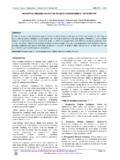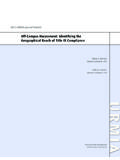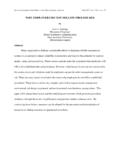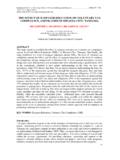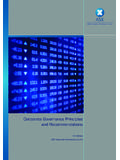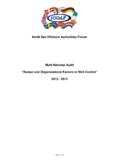Transcription of Review Article - International Journal of …
1 Volume 6, Issue 2, January February 2011; Article -005 ISSN 0976 044X International Journal of Pharmaceutical Sciences Review and Research Page 18 Available online at Sandeep Divate*, Kunchu Kavitha, Ganesh Nanjan Sockan Department of pharmaceutics, Bharathi College of pharmacy, Bharathinagara, Mandya, Karnataka-571422, India. Accepted on: 29-11-2010; Finalized on: 10-02-2011. ABSTRACT Fast disintegrating tablets (FDTs) have received ever-increasing demand during the last decade and the field has become a rapidly growing area in the pharmaceutical industry. Upon introduction into the mouth, these tablets dissolve or disintegrate in the mouth in the absence of additional water for easy administration of active pharmaceutical ingredients.
2 Such tablets readily dissolve or disintegrate in the saliva generally within <60 seconds. Fast or mouth dissolving tablets have been formulated for pediatric, geriatric, bedridden patients and for active patients who are busy and traveling and may not have access to water. Such formulations provide an opportunity for product line extension in the many elderly persons will have difficulties in taking conventional oral dosage forms (viz., solutions, suspensions, tablets, and capsules) because of hand tremors and dysphasia. Keywords: Fast disintegrating tablets, Superdisintegrants, Direct compression, wetting time. INTRODUCTION The tablet is the most widely used dosage form because of its convenience in terms of self administration, compactness and ease in manufacturing. However, many patients especially children and elderly have difficulty in swallowing tablets and capsules and consequently unable to take medicine as prescribed.
3 Almost 50% of the population is affected by such problem, resulting in the high incidence of non compliance and infective therapy. To overcome such problems, fast disintegrating tablets or orally disintegrating tablets have emerged as an alternative dosage forms. These tablets are also known as quick dissolve, fast dissolving, rapid disintegrating, mouth dissolving, melt in mouth, orodispersible or orally disintegrating tablets. 1, 2, 3 Recently Orally Disintegrating (OD) Tablet technology has been approved by United States Pharmacopoeia (USP), Centre for Drug Evaluation and Research (CDER). USFDA defined OD tablet as A solid dosage form containing medicinal substances, which disintegrates rapidly, usually within a matter of seconds, when placed upon the tongue . 4, 5, 6 Requirements of Fast disintegrating tablets It should require no water for oral administration, yet dissolve/disperse/disintegrate in mouth in a matter of seconds.
4 Have a pleasing mouth feel. Have an acceptable taste masking property. Should be harder and friable. Leave minimal or no residue in the mouth after oral administration. Exhibit low sensitivity to environmental conditions such as humidity and Salient features of Fast disintegrating tablets This system provides rapid dissolution of drug and absorption which may produce rapid onset of action. Ease of administration to patients who refuse to swallow a tablet such as pediatric, geriatric patients and psychiatric patients. No need of water to swallow the dosage form, which is highly convenient especially for patients who are traveling and do not have immediate access to water. Convenience of administration and accurate dosing as compared to liquids. Some drugs are absorbed from the mouth, pharynx and esophagus as the saliva passes down into the stomach; in such cases bioavailability of drugs is increased.
5 Conventional methods used for the preparation of Fast disintegrating tablets: Addition of superdisintegrants: A disintegrant is a substance in a tablet formulation that enables the tablet to break up into smaller fragments upon contact with gastrointestinal Superdisintegrants are used at a low level in the solid dosage form, typically 1 10% by weight relative to the total weight of the dosage unit. Examples of superdisintegrants are croscarmellose, crospovidone and sodium starch glycolate, which are a cross linked cellulose, cross linked polymer and a cross linked starch respectively. The proper choice of disintegrant and its consistency of performance are critical to formulation development of such Microcrystalline cellulose and low substituted hydroxypropylcellulose were used as disintegrating agents in the range of 8:2 to prepare fast dissolving FAST DISINTEGRATING TABLETS AN EMERGING TREND Review Article Volume 6, Issue 2, January February 2011; Article -005 ISSN 0976 044X International Journal of Pharmaceutical Sciences Review and Research Page 19 Available online at tablet.
6 Agar powder is used as disintegrant for the development of rapidly disintegration tablets by enhancing the porosity of agar by water treatment. Sodium starch glycolate, crospovidone and croscarmellose are some of the popular superdisintegrants. Direct compression: It is one of the easiest ways to manufacture tablets. Conventional equipments, commonly available excipients and a limited number of processing steps are involved in direct compression. Sawant K et al. prepared orodispersible tablets of ondansetron HCl by direct compression using superdisintegrants and they reported that in vitro dispersion time of these tablets has been found to be 5 minutes where as conventional tablets have shown 30-35 minutes. 10 Freeze drying or Lyophilization: Freeze drying is the process in which water is sublimed from the product after it is frozen.
7 This technique creates an amorphous porous structure that can dissolve rapidly. A typical procedure involved in the manufacturing of ODT using this technique is mentioned here. The active drug is dissolved or dispersed in an aqueous solution of a carrier/polymer. The mixture is done by weight and poured in the walls of the preformed blister packs. The trays holding the blister packs are passed through liquid nitrogen freezing tunnel to freeze the drug solution or dispersion. Then the frozen blister packs are placed in refrigerated cabinets to continue the freeze-drying. Sublimation: To generate a porous matrix, volatile ingredients are incorporated in the formulation that is later subjected to a process of sublimation. Highly volatile ingredients like ammonium bicarbonate, ammonium carbonate, benzoic acid, camphor, naphthalene, urea, urethane and phthalic anhydride may be compressed along with other excipients into a tablet.
8 Ex: Ravikumar et al. prepared aceclofenac fast dissolving tablets by sublimation method using camphor as subliming agent and sodium starch glycolate together with croscarmellose sodium as Mass extrusion: In this method active blend is softened using the solvent mixture of water-soluble polyethylene glycol and methanol and then subsequent expulsion of softened mass through the extruder or syringe is made to get a cylinder of the product into even segments using heated blade to form tablet. The dried cylinder can also be used to coat granules for bitter drugs and thereby achieve taste masking. Spray drying: In this technique, gelatin can be used as a supporting agent and as a matrix, mannitol as a bulking agent and sodium starch glycolate or croscarmellose or crospovidone are used as superdisintegrants. Tablets manufactured from the spray-dried powder have been reported to disintegrate in less than 20 seconds in aqueous medium.
9 Challenges in formulating Fast disintegrating tablets Palatability: As most drugs are unpalatable, rapid disintegrating drug delivery systems usually contain the medicament in a taste-masked form. Delivery systems disintegrate or dissolve in patient s oral cavity, thus releasing the active ingredients which come in contact with the taste buds; hence, taste-masking of the drugs becomes critical to patient compliance. 12, 13 Mechanical strength: The major criteria for fast dissolving tablets is to disintegrate in oral cavity is that they should be made of either very porous and soft-molded matrices or compressed into tablets with very low compression force, which makes the tablets friable, brittle, difficult to handle and often requiring specialized peel-off blister packing that may add to the ,15,16 Hygroscopicity: Several orally disintegrating dosage forms are hygroscopic and cannot maintain physical integrity under normal conditions of temperature and humidity.
10 Hence, they need protection from humidity which calls for specialized product Amount of drug: The application of technologies used for ODTs is limited by the amount of drug that can be incorporated into each unit dose. For lyophilized dosage forms, the drug dose must be lower than 400 mg for insoluble drugs and less than 60 mg for soluble drugs. This parameter is particularly challenging when formulating a fast-dissolving oral films or wafers. 18 Aqueous solubility: Water-soluble drugs pose various formulation challenges because they form eutectic mixtures, which result in freezing-point depression and the formation of a glassy solid that may collapse upon drying because of loss of supporting structure during the sublimation process. 19, 20 Size of tablet: The degree of ease when taking a tablet depends on its size. It has been reported that the easiest size of tablet to swallow is 7-8 mm while the easiest size to handle was one larger than 8 Patented technologies for Fast disintegrating tablets Zydis technology: Zydis, the best known of the fast-dissolving/disintegrating tablet preparations was the first marketed new technology tablet.



